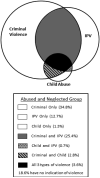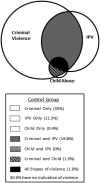Does Child Abuse and Neglect Increase Risk for Perpetration of Violence Inside and Outside the Home?
- PMID: 26191459
- PMCID: PMC4504697
- DOI: 10.1037/a0037956
Does Child Abuse and Neglect Increase Risk for Perpetration of Violence Inside and Outside the Home?
Abstract
Objective: To examine the extent to which abused and neglected children perpetrate three different types of violence within and outside the home: criminal, child abuse, and intimate partner violence and determine whether childhood maltreatment leads to an increased risk for poly-violence perpetration.
Method: Using data from a prospective cohort design study, children (ages 0-11) with documented histories of physical and sexual abuse and/or neglect (n = 676) were matched with children without such histories (n = 520) and assessed in young adulthood (average age 29). Official criminal records in conjunction with self-report data were used to assess violent outcomes.
Results: Compared to the control group, individuals with histories of child abuse and/or neglect were significantly more likely to be poly-violence perpetrators, perpetrating violence in all three domains (relative risk = 1.26). All forms of childhood maltreatment (physical and sexual abuse and neglect) significantly predicted poly-violence perpetration.
Conclusions: These findings expand the cycle of violence literature by combining the distinct literatures on criminal violence, child abuse, and partner violence to call attention to the phenomenon of poly-violence perpetration by maltreated children. Future research should examine the characteristics of maltreated children who become poly-violence perpetrators and mechanisms that lead to these outcomes.
Keywords: Child abuse and neglect; criminal violence; cycle of violence; domestic violence; intergenerational transmission; poly-violence perpetration.
Figures


Similar articles
-
Intergenerational effects of childhood maltreatment: A systematic review of the parenting practices of adult survivors of childhood abuse, neglect, and violence.Clin Psychol Rev. 2020 Aug;80:101891. doi: 10.1016/j.cpr.2020.101891. Epub 2020 Jul 23. Clin Psychol Rev. 2020. PMID: 32745835 Free PMC article.
-
Child abuse and neglect and intimate partner violence victimization and perpetration: a prospective investigation.Child Abuse Negl. 2014 Apr;38(4):650-63. doi: 10.1016/j.chiabu.2013.11.004. Epub 2013 Dec 9. Child Abuse Negl. 2014. PMID: 24325940 Free PMC article.
-
Florida: Domestic Violence.2024 Nov 25. In: StatPearls [Internet]. Treasure Island (FL): StatPearls Publishing; 2025 Jan–. 2024 Nov 25. In: StatPearls [Internet]. Treasure Island (FL): StatPearls Publishing; 2025 Jan–. PMID: 29630246 Free Books & Documents.
-
From childhood maltreatment to intimate partner violence perpetration: A prospective longitudinal examination of the roles of executive functioning and self-esteem.J Psychiatr Res. 2024 May;173:271-280. doi: 10.1016/j.jpsychires.2024.03.015. Epub 2024 Mar 14. J Psychiatr Res. 2024. PMID: 38554623 Free PMC article.
-
Kentucky Domestic Violence.2023 Apr 9. In: StatPearls [Internet]. Treasure Island (FL): StatPearls Publishing; 2025 Jan–. 2023 Apr 9. In: StatPearls [Internet]. Treasure Island (FL): StatPearls Publishing; 2025 Jan–. PMID: 29763099 Free Books & Documents.
Cited by
-
Family Violence, Sibling, and Peer Aggression During Adolescence: Associations With Behavioral Health Outcomes.Front Psychiatry. 2020 Feb 11;11:26. doi: 10.3389/fpsyt.2020.00026. eCollection 2020. Front Psychiatry. 2020. PMID: 32116843 Free PMC article.
-
Intergenerational effects of childhood maltreatment: A systematic review of the parenting practices of adult survivors of childhood abuse, neglect, and violence.Clin Psychol Rev. 2020 Aug;80:101891. doi: 10.1016/j.cpr.2020.101891. Epub 2020 Jul 23. Clin Psychol Rev. 2020. PMID: 32745835 Free PMC article.
-
"Give me some space": exploring youth to parent aggression and violence.J Fam Violence. 2018;33(2):161-169. doi: 10.1007/s10896-017-9928-1. Epub 2017 Oct 2. J Fam Violence. 2018. PMID: 29367805 Free PMC article.
-
Effects of child abuse, adolescent violence, peer approval and pro-violence attitudes on intimate partner violence in adulthood.Crim Behav Ment Health. 2016 Oct;26(4):304-314. doi: 10.1002/cbm.2014. Crim Behav Ment Health. 2016. PMID: 27709742 Free PMC article.
-
Psychometric Properties of the Child Neglect Scale and Risk Factors for Child Neglect in Chinese Young Males Who Were Incarcerated.Int J Environ Res Public Health. 2023 Mar 6;20(5):4659. doi: 10.3390/ijerph20054659. Int J Environ Res Public Health. 2023. PMID: 36901668 Free PMC article.
References
-
- Adler NE, Boyce T, Chesney MA, Cohen S, Folkman S, Kahn RL, Syme SL. Socioeconomic status and health: The challenge of the gradient. American Psychologist. 1994;49(1):15–24. - PubMed
-
- Afifi TO, MacMillan HL. Resilience following child maltreatment: A review of protective factors. Canadian Journal of Psychiatry. 2011;56(5):266–272. - PubMed
-
- Agnew R. Foundation for a general strain theory of crime and delinquency. Criminology. 1992;30:47–87.
-
- Altemeier WA, O'Connor S, Sherrod KB, Tucker D, Vietze P. Outcome of abuse during childhood among pregnant low income women. Child Abuse & Neglect. 1986;10(3):319–330. - PubMed
-
- Bandura A. Aggression: A social learning analysis. Prentice-Hall; Englewood Cliffs, NJ: 1973.
Grants and funding
LinkOut - more resources
Full Text Sources
Other Literature Sources
Miscellaneous
